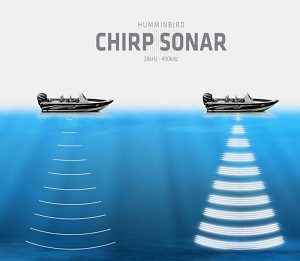
Fish finders are used to find the structures and the activities below the surfaces, but they lack precision and accuracy and often fail to recognize minor details about the underwater environment. The CHIRP is similar to the traditional fish finders but is more advanced as it sweeps the broadband of multiple frequencies used to gather different types of information.
CHIRP works very differently from the standard fish finder equipment and helps find the minor details, size, and even type of fish. In this article, we will find out how the CHIRP technology works on the fish finder and what the benefit is.
Table of Contents
How Does Chirp Technology Work On Fish Finder?
CHIRP produces a high-resolution picture that covers all the details about the underwater and the species swimming in it that would most probably remain unseen by the regular fish finders. It is the same as using more than one fish finder at the same time to gather their results on the chart display.
CHIRP Sonar usually works on the array of three different frequency ranges selected on the type of fish and the depth of the bottom. These are some of the popular frequency ranges of CHIRP. The low-frequency signal ranges from 25 to 60 kHz, the medium frequency signal has an 85 to 135 kHz range, and the high-frequency waves are based on 130 to 210 kHz signals.
The CHIRP is best suited to the high-resolution screen so that no detail is missed while displaying the results. CHIRP is a quick and powerful scanner, and in comparison to standard fish finders, they are more advanced and powerful. The fish finder is like a semi-automatic handgun that only scans a short area with low accuracy.
The CHIRP is like an automatic rifle that sweeps the site accurately. It provides an enhanced and more detailed picture of the underwater that can be used to identify the bait, fishes, structure, objects, and other things. CHIRP is available in different sizes and capabilities suited for other purposes and budgets.
The Benefits Of CHIRP
CHIRP provides many advantages and edges when compared to the standard fish finder. CHIRP offers more significant and more distinct signatures of the fishes to be distinguished easily. It also provides the benefits of seeing the fish’s reaction to the bait you provided. It gives the advantage of seeing the efficiency of the appeal.
With the help of the CHIRP, you can identify the size and the type of fish with great accuracy. You can scan deeper with more details and accuracy, providing excellent reliability. The images are distinct, and you can even count the fishes beneath the surface. The results are better with less distortion that can hide the target fish and structure. It can cover a reasonably large area and with great accuracy.
Different Band Of CHIRP
The CHIRP is used in multiple frequencies that are adjusted based on the environment in which you are fishing. These are the most common CHIRP frequency ranges.
High CHIRP
High CHIRP covers the frequency range from 130 to 210 kHz, and these are ideal for the scan of the bay, inlet, coast, etc. they can be used to see the depth of up to 600 feet when combined with a high power source.
Medium CHIRP
Medium CHIRP covers the frequency range from 85 to 135 kHz, and these are used to cover more area at the cost of the accuracy and pixel. They can be used to see the depth of up to 600 feet when combined with a high power source.
Low CHIRP
They include frequencies between 25 to 60 kHz and are suited for bottom fishing.
Conclusion
CHIRP provides tremendous advantages over the regular fish finder as it can be used to scan a large area with great accuracy. They can be used to identify the size and type of fish and can be used to differentiate between structures.
- What Do You Need for Fishing - August 18, 2022
- How to Find Offshore Fishing Spots - August 18, 2022
- What to Use for Trout Fishing - August 17, 2022
